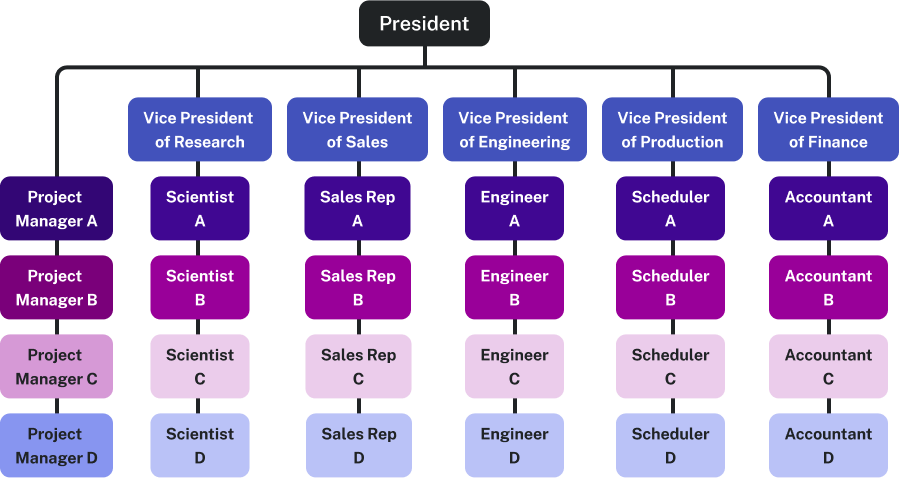Contemporary Structures
Although traditional forms of departmentalization still represent how many companies organize their work, newer, more flexible organizational structures are in use at many firms. Let’s look at matrix and committee structures and how those two types of organizations are helping companies better leverage the diverse skills of their employees.
Matrix Structure
The matrix structure is a type of organizational structure in which individuals are grouped by two different operational perspectives at the same time; this structure has both advantages and disadvantages but is generally best employed by companies large enough to justify the increased complexity.

In a matrix structure, the company is organized by both product and function. Product lines are managed horizontally, and functions are managed vertically. This means that each function—e.g., research, sales, engineering, production, and finance—has separate internal divisions for each product. In matrix organizations, the company is grouped by the perspectives it deems most appropriate. Common organizational perspectives include function and product, function and region, or region and product.In an organization grouped by function and product, for example, each product line will have management that corresponds to each function. If the organization has three functions and three products, the matrix structure will have nine (3×3) potential managerial interactions. This example illustrates how inherently complex matrix structures are compared to other, more linear structures.
Advantages of the matrix structure include:
- Teamwork. By pooling the skills and abilities of various specialists, the company can increase creativity and innovation and tackle more complex tasks.
- Efficient use of resources. Project managers use only the specialized staff they need to get the job done, instead of building large groups of underused personnel.
- Flexibility. The project structure is flexible and can adapt quickly to changes in the environment; the group can be disbanded quickly when it is no longer needed.
- Ability to balance conflicting objectives. The customer wants a quality product and predictable costs. The organization wants high profits and the development of technical capability for the future. These competing goals serve as a focal point for directing activities and overcoming conflict. The marketing representative can represent the customer, the finance representative can advocate high profits, and the engineers can push for technical capabilities.
- Higher performance. Employees working on special project teams may experience increased feelings of ownership, commitment, and motivation.
- Opportunities for personal and professional development. The project structure gives individuals the opportunity to develop and strengthen technical and interpersonal skills.
Disadvantages of the matrix structure include:
- Power struggles. Functional and product managers may have different goals and management styles.
- Confusion among team members. Reporting relationships and job responsibilities may be unclear.
- Lack of cohesiveness. Team members from different functional areas may have difficulty communicating effectively and working together as a team.
Matrix structures should generally only be used when the operational complexity of the organization warrants it. A company that operates in various regions with various products may require interaction between product development teams and geographic marketing specialists—suggesting a matrix may be beneficial. Larger companies with a need for a great deal of cross-departmental communication generally benefit the most from this model.